07 Jul Sealing a Terrazzo Floor

Terrazzo Sealers
Sealing a terrazzo floor is the final step of a terrazzo installation. Once a sealer is applied, a terrazzo floor can be walked upon.
In this blog, we address the purpose of sealers and why they are important in maintaining a terrazzo floor during its lifecycle.
What is the purpose of a terrazzo sealer?
The purpose of the sealer is to protect the aggregate and the terrazzo itself from the elements of dirt, moisture intrusion, and stains. Sealers also enhance the aesthetics of the terrazzo floor.
Applying a sealer occurs following the final polishing of the terrazzo. Installers will clean the surface and allow the surface to dry before applying multiple coats of sealer.

Should terrazzo be sealed?
According to the National Terrazzo and Mosaic Association, all terrazzo should be sealed. It is common practice that a terrazzo contractor installs a sealer recommended by the manufacturer. Sealing is required to display the true color of aggregates and must be resealed occasionally.
It is also important to avoid using the wrong type of sealers to get the best finish for the terrazzo floor. Apply only sealers recommended for terrazzo. Never use all-purpose sealers.
What is the best sealer for terrazzo?
Water-based sealers are recommended for terrazzo floors. They are widely adopted by terrazzo contractors for epoxy terrazzo floors that offer high performance and have zero levels of VOC (volatile organic compounds), making them easy to work with and less harmful to the environment.
For epoxy terrazzo installations using TERRAZZCO EZpour Epoxy 158, it is recommended to pair Betco Sure Cure and Untouchable. The more coats applied, the higher the gloss level. But typically the floor finish will receive 2-4 coats.


How do you seal terrazzo?
Sealing occurs after the terrazzo floor has been polished. The floor is cleaned using fresh water and neutral cleaner then left to completely dry. Once the terrazzo floor is dried, an installer will apply a thin coat of sealer to a microfiber pad. Installers will apply sealer in thin coats over heavy coats.
The entire area is applied with one coat of sealer. Once the first coat has dried, a second coat is applied to the terrazzo floor. It is suggested to apply these coats of sealer in a cross-directional manner.
After two coats of sealer have been applied, the terrazzo installation is complete. At this time, the terrazzo project can be turned over to the general contractor. The floors are protected until it is time for the building to open to the public.

How often should you reseal terrazzo?
New terrazzo floors require two or more coats of sealer. This will provide a good sheen for the floor for about 45 to 60 days before needing additional coats.
As the terrazzo ages, the floor will require resealing. This is dependent on the amount of traffic the terrazzo is exposed to and the type of sealer used.
To give you an idea of how often it takes to reseal a terrazzo floor, here is our technical representative’s advice when using Betco sealers with TERRAZZCO products:
Sure Cure is a great initial protective coating to be applied by the terrazzo contractor right after install. It can be left by itself or a finish coat can be applied over the top such as Betco Untouchable (by the maintenance team/ownership).
If ownership chooses to use only Sure Cure, the sealer should probably be reapplied 1-2 times per year in high traffic areas with 2-3 coats (stripping is required).
If the floor finish is applied on top of the sealer (Untouchable), you can simply burnish the floor and apply additional coats of floor finish (Untouchable). This would reduce the need for a complete strip and reseal to as little as once every 5 years or so. If the finish coat is being well maintained, the sealer coat will last much longer. Untouchable will save the owners time and money in the maintenance portion of their business.
Recommendation for owners:
- Burnish existing floor with Sure Cure applied to ensure the surface is completely clean.
- Dust mop to ensure all dry debris from the burnishing process is removed.
- Apply 2-4 coats of Betco Untouchable Floor Finish in alternating hatch pattern allowing each layer to cure completely. If a high gloss appearance is desired, burnish the floor one more time. Each coat of Untouchable will add to the gloss level. If you apply 4-5 coats and burnish, this should look like glass.
- The Untouchable Finish Coat will protect the sealer coat and you can simply come back and burnish, add more Untouchable, burnish as needed when you can see the sealer becoming a little dull.
- Burnishing is needed to get the surface completely clean to prevent dirt from being trapped between the old finish coat and the new finish coat. It is important to not apply more finish coat over a dirty layer of finish as the floor will never look clean.






